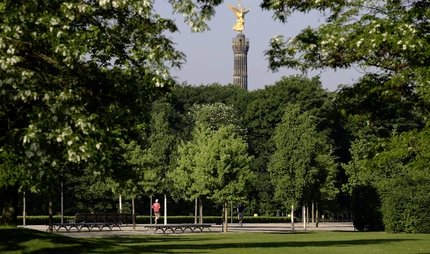
Park at Gleisdreieck
Track beds into rose gardens
The Park am Gleisdreieck is located on a former railway area around the traffic junction. Now it's one of Berlin'S most popular parks.
Berlin has long since been able to consider itself a metropolis with green fingers. There are many small and large recreation and leisure areas, especially in the inner-city districts. And in the future it is also intended to adhere to a healthy mixture of redevelopment and open spaces. The latest example of this urban planning concept is the recently created Park am Gleisdreieck (Gleisdreieck Park) in Kreuzberg. The railway area around the traffic junction at Gleisdreieck became a wasteland at the end of the Second World War, and developed a rich diversity of vegetation almost unnoticed. A citizens’ group was formed with the aim of ensuring a permanent existence for this unhoped-for refuge reclaimed by flora and fauna surrounded by dense redevelopment, and in the end they were successful. Many proposals and criticisms by residents were integrated into the planning process, which was notable for the strong public involvement. After its completion in 2013, the Park am Gleisdreieck connects to the green areas of the government quarter and Potsdamer Platz, and extend them in a southerly direction to the nature park at Schöneberger Südgelände. The eastern part of this park was opened in September 2011 and with its 17 hectares (42 acres) represents the larger part of the total area of 26 hectares (64 acres) that will be created between Tempelhofer Ufer and Yorckstraße. An ICE railway line cuts through this area in a north-south direction separating the two elements of the park from each other.
The park today
The park has been awarded the German Landscape Architecture Prize 2015 for produces outstanding quality in design and construction through to property and detailed planning. An essential element of the park architecture is the preservation of the ruderal flora, i.e. the proliferation, which was once prevented by the old railway installation. Some of the old signalling and railway facilities are still present in the park, giving it its own particular flair. The intercultural Rosenduftgarten (Rose Scent Garden) is especially worthwhile visiting, as it is cultivated by various neighbourhood communities and therefore a riotous mix of colours is to be expected. In contrast, there’s rather more activity going on in the nature discovery area, where city kids can really get stuck into playing in the mud and experiencing the natural environment at close quarters. There’s also a museum railway operating, continuing the distinctive motif of its railway origins. Skaters can enjoy one of the largest skating areas in the city, and there’s plenty of room for joggers, table-tennis players and yoga lovers to pursue their passions. In 2013 the western part of the park was opened, where there’ll also be plenty of open spaces for botanical and sporting activities.
A children's park
The extensive lawns provide plenty of space for a delicious picnic or impromptu ballgame. In the nature experience area children aged between 6 and 12 can also discover animals and plants, play hide and seek or, in summer, splash in the water-filled hollows. And of course there are also a number of playgrounds to be conquered by younger or older children.



